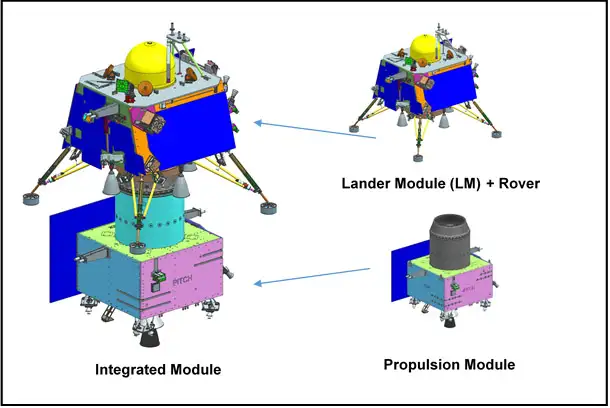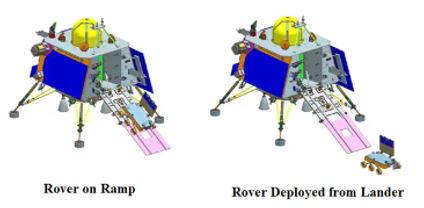Chandrayaan – 3: A Wizard for Indian Agriculture plant
Shanju Kumar S, Akhouri Nishant Bhanu*, Ashok Saxena and M. Yasin
July 19th 2025, 11:59:46 pm | 5 min read

In the not-so-distant future, the concept of space exploration has transcended science fiction and become a reality. As governments and private enterprises collaborated to explore the cosmos, the Moon has stood as one of the frontiers. A major contribution to the advancement of agriculture may be made by space exploration and related technologies. In order to improve crop productivity, manage resources more effectively, and lessen environmental issues, farmers and agricultural scientists may benefit from these technologies by getting vital data and tools.
Chandrayaan-3 is a pride for all Indians. It has made history by becoming the first mission to soft-land on the lunar south pole, a region that has never been explored before. In order to show end-to-end capabilities in safe landing and wandering on the lunar surface, Chandrayaan-3 is a follow-up mission to Chandrayaan-2. It was launched aboard an LVM3-M4 rocket from Satish Dhawan Space Centre on 14 July 2023. The spacecraft entered lunar orbit on 5 August, and the lander touched down near the Lunar South Pole on 23 August at 18:03 IST. The successful moon landing of Chandrayaan-3 was achieved on a budget of around ₹615 crore. It consists of Lander and Rover configuration. The propulsion module carried the lander and rover configuration to 100 km lunar orbit. It was successfully landed on the south pole of the moon making India the only country to achieve it, and this mission joins us in the elite club of moon landings comprising only four countries (USA, Russia, China, and India). Chandrayaan-3 is a breakthrough for India in space technology, however, this can also be very useful in improving agriculture technology.
Lander payloads :
It has Chandra’s Surface Thermophysical Experiment (ChaSTE) to measure the thermal conductivity and temperature. The Instrument for Lunar Seismic Activity (ILSA) for measuring the seismicity around the landing site; Langmuir Probe (LP) to estimate the plasma density and its variations. A passive Laser Retroreflector Array from NASA was accommodated for lunar laser ranging studies.
Rover payloads :
It comprises of Alpha Particle X-ray Spectrometer (APXS) and Laser Induced Breakdown Spectroscope (LIBS) for deriving the elemental composition near the landing site.

Figure 1 Source- https://www.isro.gov.in/Chandrayaan3Details.html
The main objectives of Mission Chandrayaan-3 were:
• To demonstrate a Safe and Soft Landing on the Lunar Surface
• To demonstrate Rover roving on the moon and
• To conduct in-situ scientific experiments
Achievements of Chandrayaan- 3
• Establishing India as part of an exclusive club of lunar landing nations.
• Boosting national and economic pride.
• Catalyzing the private space sector.
• Advancing space technology.
• Discovering the presence of minor elements like Al, S, Ca, Fe, Cr, and Ti.
• Finding the temperature of the moon's surface and atmosphere.
• Discovering the presence of Sulphur in the moon.

Figure 2 Source - https://www.isro.gov.in/Chandrayaan3_Details.html
IMPACT OF CHANDRYAAN – 3 ON AGRICULTURE
The Chandrayaan 3 was conducted mainly to achieve the moon landing capabilities and rover capabilities, but the instruments used in Chandrayaan 3 can be used in agriculture for better and more efficient farming practices. The Chandrayaan 3 was also designed to check the mineral status of the moon's surface and the temperature variation in the moon's atmosphere and surface which will lead to future farming on the moon.
Space breeding (Space Inspired Mutation Breeding) refers to the technique of inducing mutation in the seeds or microorganisms by sending them into space on a recoverable satellite or in another recoverable spacecraft. Space breeding, also known as space agriculture or astro-agriculture, is a scientific and agricultural practice that involves growing plants and crops in the unique environment of outer space. This concept has been explored to address various challenges and opportunities related to food production and plant growth in space, especially for long-duration space missions, such as those to the Moon or Mars. The success of this mission will be a boost for space breeding programs as it proves the capabilities of performing space breeding.
POSSIBLE USE OF CHADRAYAAN -3 TECHNOLOGIES IN AGRICULTURE
The technologies developed for the Chandrayaan missions, which are India's lunar exploration missions, primarily focus on lunar exploration and space science. However, some of the technologies and scientific knowledge gained from these missions could potentially find applications in agriculture on Earth.
The Alpha Particle X-Ray Spectrometer (APXS) technology used in the Pragyan rover can be used in determining the soil mineral content rapidly after making it economical to use. To derive the chemical Composition and infer mineralogical composition to further our understanding of the lunar surface. APXS observations have discovered the presence of interesting minor elements, including Sulfur, apart from the major expected elements such as Aluminum, Silicon, Calcium, and Iron. It may be recalled that the LIBS instrument onboard the Rover also confirmed the presence of Sulfur. Detailed scientific analysis of these observations is in progress. Materials science research for spacecraft components can lead to the development of new materials that have applications in agriculture, such as improving the durability of farming equipment, developing more efficient and durable greenhouses, or creating lightweight and strong structures for agricultural purposes.
The laser-induced breakdown spectroscopy (libs) used in Chandrayaan 3 can be used in soil testing. The Laser-Induced Breakdown Spectroscopy (LIBS) instrument onboard Chandrayaan-3 Rover has made the first-ever in-situ measurements on the elemental composition of the lunar surface near the South Pole. Preliminary analyses, graphically represented, have unveiled the presence of Aluminum (Al), Sulphur (S), Calcium (Ca), Iron (Fe), Chromium (Cr), and Titanium (Ti) on the lunar surface. Further measurements have revealed the presence of manganese (Mn), silicon (Si), and oxygen (O). A thorough investigation regarding the presence of Hydrogen is underway.
Chandrayaan missions have utilized advanced remote sensing and imaging technologies to study the lunar surface. These technologies could be adapted for Earth-based agriculture to monitor crop health, detect diseases, and assess soil conditions. Remote sensing data can provide valuable insights to farmers and help optimize crop management. They utilized solar panels to generate power. Solar energy technology developed for space missions can be used to provide clean and sustainable energy solutions for agricultural operations, such as powering irrigation systems, equipment, and rural electrification in off-grid areas.
The data collected during Chandrayaan missions is analyzed using sophisticated algorithms and models. These data analytics techniques can be applied to agriculture for crop modelling, yield prediction, and optimizing farming practices. The Chandrayaan missions involve the study of water molecules on the Moon. Knowledge about water management and detection can be adapted for improving irrigation practices, water conservation, and groundwater monitoring in agriculture.
Chandrayaan 3 can be a wizard for the technology used in agriculture and lead to a new phase of innovation in agriculture technology and hence improve agriculture production. While the direct application of Chandrayaan technologies in agriculture may require adaptation and further development, the knowledge, innovation, and expertise gained from space missions can indirectly benefit agriculture by fostering cross-disciplinary collaborations and driving technological advancements that can be transferred to various sectors, including agriculture, to improve food production, resource management, and sustainability.
The universe is a canvas for our dreams and aspirations, waiting for the pioneers to paint its story in the stars. As we look to the stars, it's not just about what we can find out there; it's also about what we can bring back to Earth and sow as seeds of inspiration for future generations.
References
• ISRO official website, www.isro.gov.in
• NASA official website, www.nasa.gov
• European Space Agency, www.esa.int